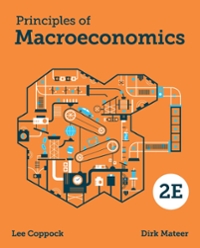Any help please.
Question 1
Information processed by one party in a financial transaction but not by the other party is called
a. asymmetric information.
b.moral hazard.
c. financial intermediation.
d. adverse selection information.
Question 2
Consider a welfare program in which individuals who do not earn any income receive 510C! in benets but benefits decrease with earned income: for each dollar earned 5t} cents of benets are withdrawn and this is so for any earnings above 50. {3} Assume that an individual can earn 510 per hour and has no other income. Sketch her budget constraint with and without the program in effect. Carefully label the axes. intercepts and link points. {1 point] [b] For an individual earning 5101} dollars before the introduction of the welfare plan explain how hours of work and total income are affected by the introduction of such a welfare plan. Use the diagram to {i} iiiustrate the income and substitution effects of the welfare program and {ii} show how a fixed subsidyI could lead that individual to the same level of utility at lower cost. [3 points} {c} For an individual earning 5200 dollars before the introduction of the welfare plan explain how hours of work and total income are affected by the introduction of such a welfare plan. Use the diagram to show how a fixed subsidy of the same magnitude as the decreasing subsidy the individual receives within the welfare program would have allowed the individual to reach a higher level of utility. {3 points] [d] Discuss the advantages and disadvantages of means testing welfare benefits. {3 points} Consider the Mundell-Fleming short-run model of a small open economy under floating exchange rates described by the following equations (1) through (7). Assume that there are free capital flows and that interest rate parity holds so that r = r* where r* = 5 is the world interest rate. (1) C = 400+0.8 (Y - T); (2) 1 = 850 -60r*; (3) G =1200; (4) T=1000 + 0.25Y; (5) NX = 600 - 200e; (6) Y = C + 1 + G + NX; (7) (M/P )= 0.5Y -50r*. Equation (6) is the goods market equilibrium condition (IS* equation), while equation (7) is the LM* equation. The nominal money supply is M = 4000, the fixed domestic price level is P = 2 while the foreign price level is P*=1. In equation (5), e is the nominal exchange rate. In this economy, the equilibrium nominal exchange rate e* is equal to:20. If Home expected real interest rate is greater than Foreign expected real interest rate and if the Real Interest Parity holds, which of the following is correct. A. Expected real exchange rate is greater than the spot real exchange rate. B. Expected real exchange rate is less than the spot real exchange rate. C. Expected real exchange rate equals to the spot real exchange rate. 08:43 D. The relationship between Expected real exchange rate and spot real exchange rate is uncertain. PART II. Short Questions (33 pts) 1. Consider a real money demand function in the Home country. L(RH. YH) = YA.5 RH] where Y, R and L(R, Y) are output, nominal interest rate, and real money demand respectively. Set Home country money supply My = 16, Home country price level PH = 2, Home country output Y# = 4, Foreign interest rate RF = 0.15 and expected exchange rate of Home per unit of Foreign currency ER/F = 2.5. (11 pts) a. What is the percentage change in real money demand when output increases by 1%? (11 pts) b. Compute the equilibrium exchange rate and interest rate in the short run. (11 pts) c. In the short run, when Money supply increase from 16 to 20. What is the new equilibrium the equilibrium exchange rate and interest rate? Answer:3. The Open Economy IS-LM Consider an open economy characterized by the following equations for domestic demand: C =150 + 0.6YD 1 = 250 + 0.15Y - 1000i G = 300 T = 100 where C is consumption, Yo is disposable income, I is investment, Y is output, i is the nominal interest rate, G is government spending and T are taxes. Net exports (NX) are given by: NX = 0.2Y* - 0.25Y - 100e; where & is the real exchange rate [&=E(P/P*)] and Y* is foreign output Also assume that: 1) P/p* = 1; Y* = 1500; i* = 0.10 (i* is the nominal interest rate on foreign bonds); E = 1.10 (E is the expected nominal exchange rate) (a) Calculate the nominal exchange rate if the central bank sets the domestic nominal interest rate at [use the interest parity condition; E - (1+i)E / (1+i*)]: (i) 5% (ii) 10% (b) Use the goods market equilibrium condition Y= C + 1 + G + NX to solve for equilibrium output, when the central bank sets the nominal interest rate at i=0.10. (c) Briefly describe the two ways in which the domestic nominal interest rate affects equilibrium output. (d) At the equilibrium output, calculate the budget deficit (G - T) and the trade balance (NX). What would happen to the budget deficit and to the trade balance if taxes were to increase? 08.42Question 7 1 pts 6. In Q.5 suppose that Clarke's utility function is C+ co (i.e., Cg, Cb are perfect one-to-one substitutes). (a) If insurance costs $0.5 for every $1 of insurance coverage Clarke will never insure completely (i.e., he will never choose x = 2). O (b) If insurance costs $0.75 for every $1 of insurance coverage Clarke will not insure at all (i.e., he will choose x = 0) O (c) If insurance costs $0.25 for every $1 of insurance coverage Clarke will not insure at all (i.e., he will choose x = 0). O (d) Clark is always indifferent to the amount he insures because the nature of his utility function is such that he is risk neutral











